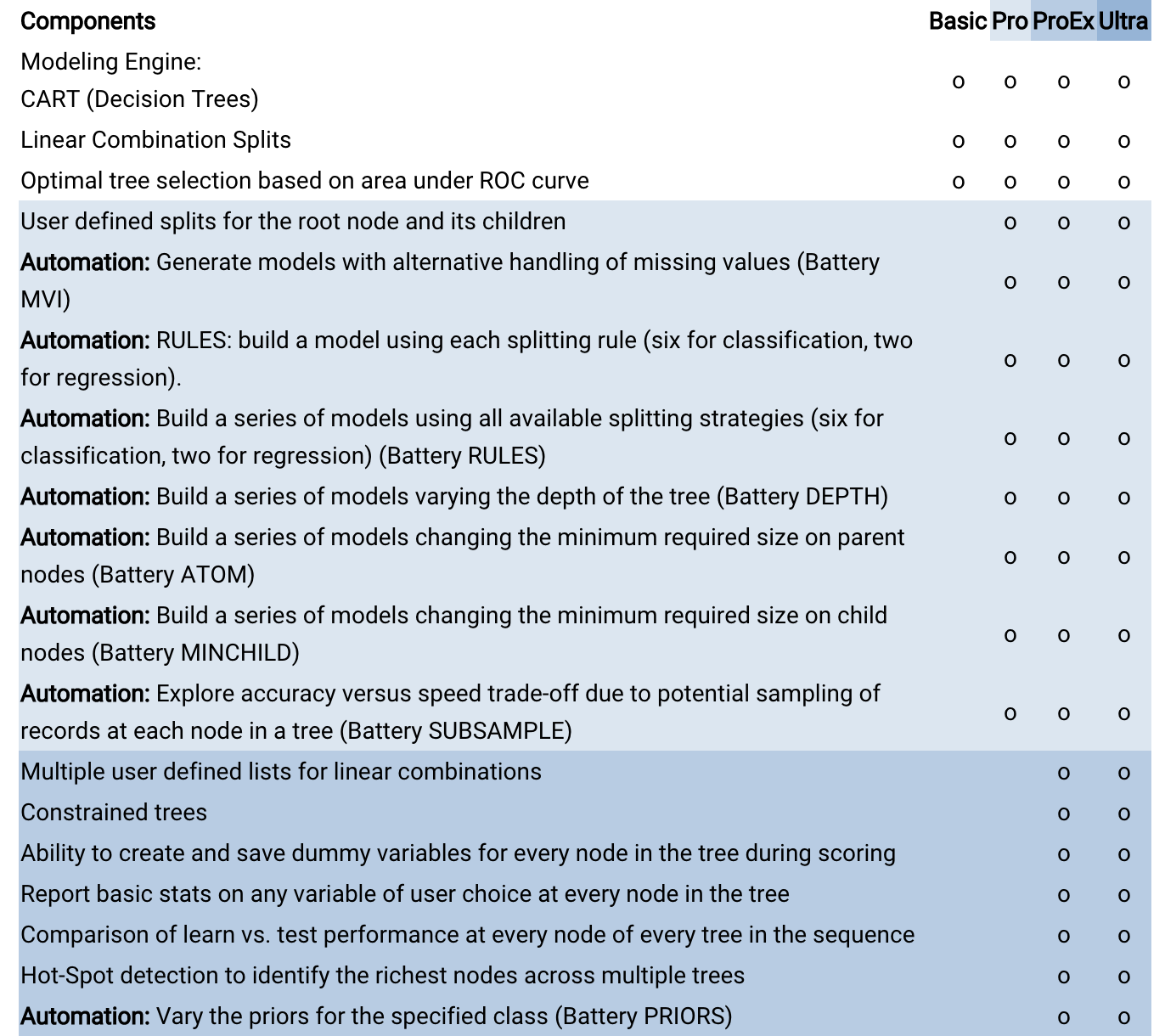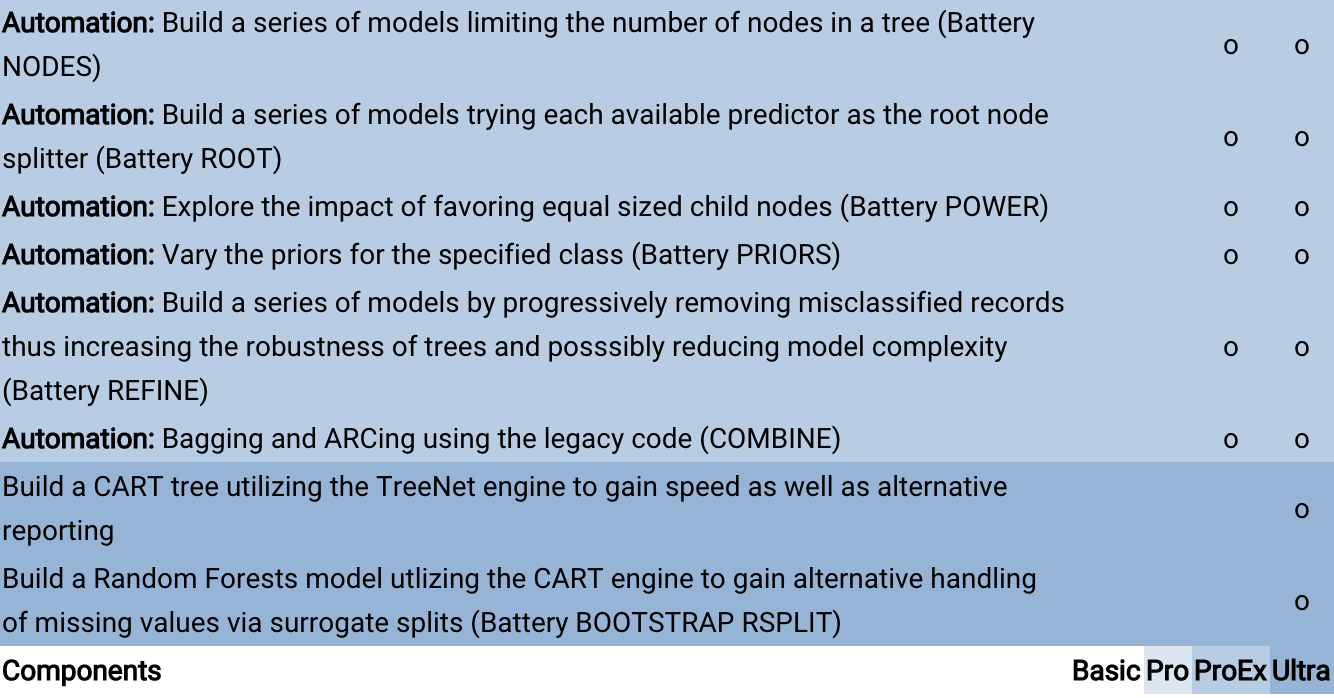| |
 by by 
Product Description Ultimate Classification Tree:
CART is the ultimate classification tree that has revolutionized the
entire field of advanced analytics and inaugurated the current era of
data mining. CART, which is continually being improved, is one of the
most important tools in modern data minging. Others have tried to copy
CART but no one has succeeded as evindeced by unmatched accuracy,
performance, feature set, built-in automation and easue of use.
Designed for both non-technical and technical users, CART can quicly
reveal important data relatioinships that could remain hidden using
other analytical tools..
Proprietary Code:
Technically, CART is based on landmark mathematical theory introduced
in 1984 by four world-renowned statisticians at Stanford University and
the University of California at Berkely. Salford Systems'
implenmentation of CART is the only decision tree software embodying
the original proprietary code. The CART creators continure to
collaborate with Salford Systems to continually enhance CART with
proprietary advances.
Fast and Versatile:
Patented extensions to CART are specifically designed to enhance
results for market research and web analytics. CART supports high-speed
deployment, allowing Salford models to predict and score in real time
on a massive scale. Over the years CART has become known as the fastest
and most verstaile predicitve modeling algorithm available to analyst
it is also used as a foundation to many modern data mining approached
based on bagging and boosting.

Principal Characteristics



Supported File Types
The CART®
data-translation engine supports data conversions for more than 80 file
formats, including popular statistical-analysis packages such as SAS®
and SPSS®, databases such as Oracle and Informix, and spreadsheets such
as Microsoft Excel and Lotus 1-2-3.

Model Deployment
Any CART model can be
easily deployed when translated into one of the supported languages
(SAS®-compatible, C, Java, and PMML) or into the classic text output.
This is critical for using your CART trees in large scale production
work.
The decision logic of a CART tree, including the surrogate rules
utilized if primary splitting values are missing, is automatically
implemented. The resulting source code can be dropped into external
applications, thus eliminating errors due to hand coding of decision
rules and enabling fast and accurate model deployment.

Data Translation Engine
The CART® data-translation engine
supports data conversions for more than 80 file formats, including
popular statistical-analysis packages such as SAS® and SPSS®, databases
such as Oracle and Informix, and spreadsheets such as Microsoft Excel
and Lotus 1-2-3.

Which version do you need?
Product Versions
ULTRA
The best of the best. For the modeler who must have access to leading
edge technology available and fastest run times including major
advances in ensemble modeling, interaction detection and automation.
ULTRA also provides advance access to new features as they become
available in frequent upgrades.
PROEX
For the modeler who needs cutting-edge data mining technology,
including extensive automation of workflows typical for experienced
data analysts and dozens of extensions to the Salford data mining
engines.
PRO
A true predicitve modeling workbench designed for the professional data
miner. Varitey of supporting conventional statisitical modeling tools,
programming language, reporting services, and a modest selection of
workflow automation options.
BASIC
Literally the basics. Salford Systems award winning data mining engines
without extensions or automation or surrounding statistical services,
programming language, and sophisticated reporting. Designed for small
budgets while still delivering our world famous engines.

System Technical Requirements
Windows
Minimum System Requirements
- 80486 processor or higher.
- 512MB
of random-access memory (RAM). This value depends on the "size" you
have purchased (64MB, 128MB, 256MB, 512MB, 1GIG). While all versions
may run with a minimum of 32MB of RAM, we CANNOT GUARANTEE it
will. We highly recommend that you follow the recommended memory
configurationthat applies to the particular version you have purchased.
Using less than the recommended memory configuration results in hard
drive paging, reducing performance significantly, or application
instability.
- Hard disk with 40 MB of free space for program files, data file access utility, and sample data files.
- Additional hard disk space for scratch files (with the required space contingent on the size of the input data set).
- CD-ROM or DVD drive.
Recommended System Requirements
Because
Salford Tools are extremely CPU intensive, the faster your CPU, the
faster they will run. For optimal performance, we strongly recommend
they run on a machine with a system configuration equal to, or greater
than, the following:
- Pentium 4 processor running 2.0+ GHz.
- 2 GIG of random-access memory (RAM). This value
depends on the "size" you have purchased (64MB, 128MB, 256MB, 512MB,
1GIG). While all versions may run with a minimum of 32MB of RAM, we
CANNOT GUARANTEE it will. We highly recommend that you follow the
recommended memory configuration that applies to the particular version
you have purchased. Using less than the recommended memory
configuration results in hard drive paging, reducing performance
significantly, or application instability.
- Hard disk with 40 MB of free space for program files, data file access utility, and sample dta files.
- Additional hard disk space for scratch files (with the required space contingent on the size of the input data set).
- CD-ROM or DVD drive.
- 2 GIG of additional hard disk space available for virtual memory and temporary files.
Ensuring Proper Permissions
If you are installing on a machine that uses security permissions, please read the following note:
- You must belong to the Administrator group on Windows
2003 / 2008, Windows 7/8 to be able to properly install and license.
ONce the application is installed and licensed, any member with
read/wirte/modify permissions to the applications/ bin and temp
directories can execute and run the application/
Licensing Application
CART uses a system of
application system ID and associated unlock key. Upon installation
completion, the user will need to email the application "system ID."
This system ID is clearly displayed in the License Information
displayed the first time the application is
started. You can alternatively get to this window by selecting the Help->License menu option.
Method 1: Fixed License
With a fixed license, each machine must have its own copy of the
licensed program installed. If your license terms permit more than one
copy, then the license must be activated on each machine that will be
used.
Method 2: Floating License
This method of licensing your program is used if you intend the program
application to be used by more than one user concurrently over a
network. A floating license tracks the number of copies "checked out".
When that number exceeds your license terms, a
message is provided informing the user "all copies are checked out".
The licensed program may be installed on a machine that each client
machine can access. Machines that are not connected to the network must
be issued a fixed license (Method 1 above).
A floating license is particularly useful when the number of potential
users exceeds the number of seats specified in your license terms.
UNIX/Linux
Supported Architectures
- Alpha: DEC 3000 or AlphaServer running Tru64 UNIX 5.0 or higher
- Linux/i386: i586 or higher processor; Linux 2.4 or higher kernel; glibc 2.3 or higher
- Linux/AMD64: AMD64 or Intel EM64T processor; Linux 2.6 or higher kernel; glibc 2.3 or higher
- Sun: UltraSPARC processor; Solaris 2.6 or higher
- RS/6000: POWER or PowerPC processor; AIX 4.2 or higher
- HP 9000: PA/RISC 1.1 or higher processor; HP/UX 11.x
- SGI: MIPS 4 or higher processor; IRIX 6.5
Minimum System Requirements
- Minimum RAM requirement for all non-GUI app's is 32 MB of random-access memory (RAM). This value depends on the "size"
you have purchased (64MB, 128MB, 256MB, 512MB, 1GIG).
- Hard disk with 40 MB of free space for program files, data file access utility, and sample data files.
- Additional hard disk space for scratch files (with the required space contingent on the size of the input data set).
Recommended System Requirements
- Recommended random-access memory (RAM) is 1.5 times
the licensed data limit (32 MB, 64 MB, etc), up to the maximum
permitted by the target architecture. On UNIX systems, it is generally
recommended that there be at least twice as much swap space as there is
RAM.
- Hard disk with 40 MB of free space for program files, data file access utility, and sample data files.
- Additional hard disk space for scratch files (with the required space contingent on the size of the input data set).
All Salford apps are very CPU intensive, so more memory and a faster CPU are always helpful.
© Copyright 2015 Salford-Systems Inc.


|
|



